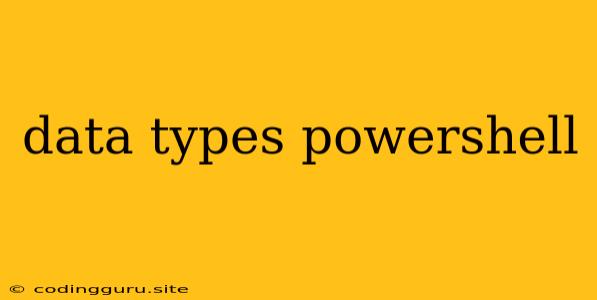Understanding Data Types in PowerShell
PowerShell is a powerful scripting language widely used for automating tasks and managing systems. One of the fundamental concepts you need to grasp is data types. Data types determine the kind of information a variable can hold. PowerShell handles different data types, each designed for specific purposes. This article explores the various data types available in PowerShell and how they can be used effectively.
What Are PowerShell Data Types?
Imagine you're building a house. You wouldn't use the same materials for the walls, roof, and foundation, right? Similarly, in PowerShell, data types are like building blocks that define the kind of data your scripts will work with. They tell PowerShell how to interpret and manipulate the information stored in variables.
Common PowerShell Data Types
Here are some common data types in PowerShell:
- String: Textual data enclosed in double quotes (").
- Example:
$name = "John Doe"
- Example:
- Integer: Whole numbers (positive or negative).
- Example:
$age = 30
- Example:
- Double: Decimal numbers with a fractional part.
- Example:
$price = 19.99
- Example:
- Boolean: Represents a true or false value.
- Example:
$isCompleted = $true
- Example:
- DateTime: Represents a specific date and time.
- Example:
$currentDate = Get-Date
- Example:
- Array: A collection of elements, all of the same data type.
- Example:
$numbers = @(1, 2, 3, 4)
- Example:
- Hashtable: A collection of key-value pairs.
- Example:
$user = @{Name = "John Doe"; Age = 30}
- Example:
Why Are Data Types Important?
Understanding data types is crucial for writing accurate and efficient PowerShell scripts. Here's why:
- Data Integrity: Using the correct data type ensures that your data is handled appropriately. You wouldn't store a person's name in a numeric variable, right?
- Operations: PowerShell performs operations based on the data types involved. For example, you can add two numbers together, but you can't add a number to a string.
- Error Prevention: By understanding data types, you can avoid unexpected errors and ensure your scripts work as intended.
Determining a Variable's Data Type
You can check the data type of a variable using the Get-Member cmdlet. For example:
$name = "John Doe"
$name | Get-Member -MemberType Property
# Output:
TypeName: System.String
This shows that the variable $name is of type System.String.
Working with Data Types
PowerShell provides functions for converting data between data types. Here are some useful examples:
-
Casting: You can explicitly convert a variable to another data type using casting.
- Example:
[int]$age = "30"(Converts the string "30" to an integer).
- Example:
-
Type Conversion Functions: PowerShell offers specific functions for conversions.
- Example:
$price = [double]"19.99"(Converts the string "19.99" to a double).
- Example:
Conclusion
Understanding data types is a fundamental step in becoming a proficient PowerShell user. By understanding how different data types work, you can write robust and reliable scripts that effectively manage your systems and automate tasks. Remember to always use the appropriate data type to ensure data integrity, proper operations, and prevent unexpected errors.
